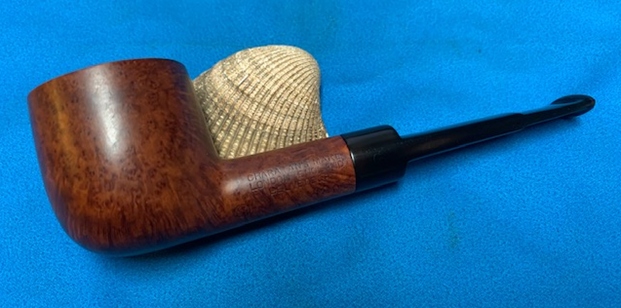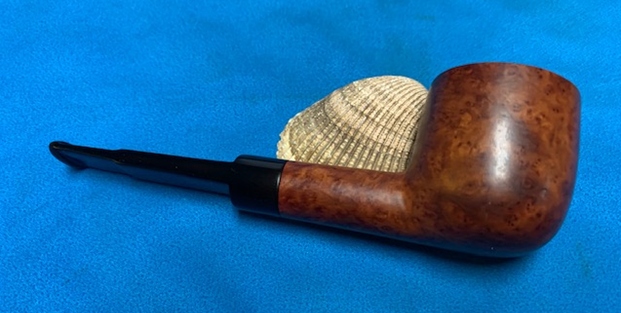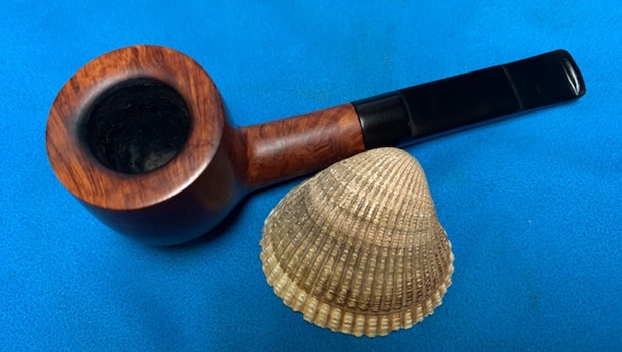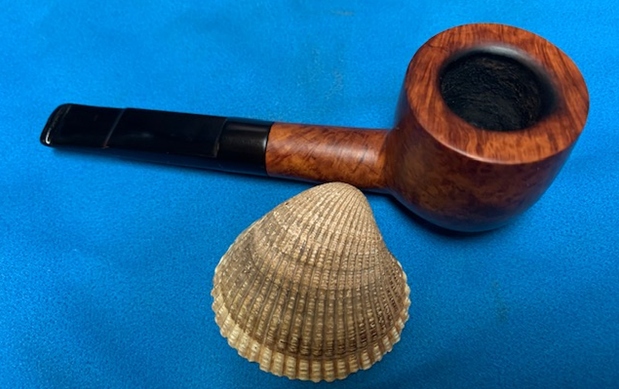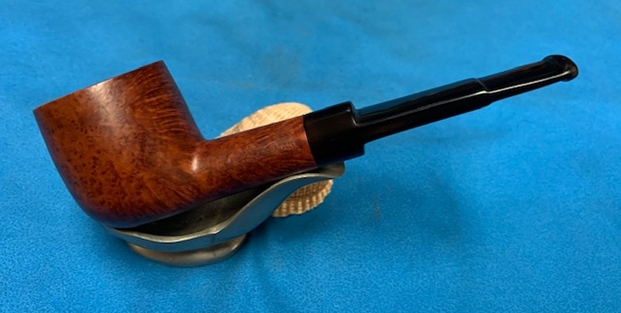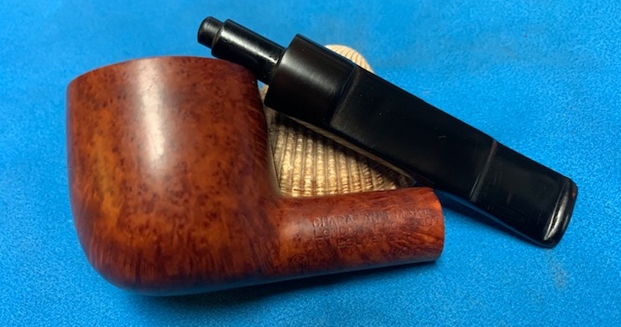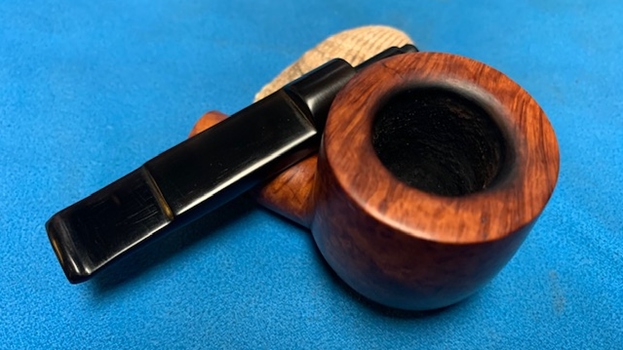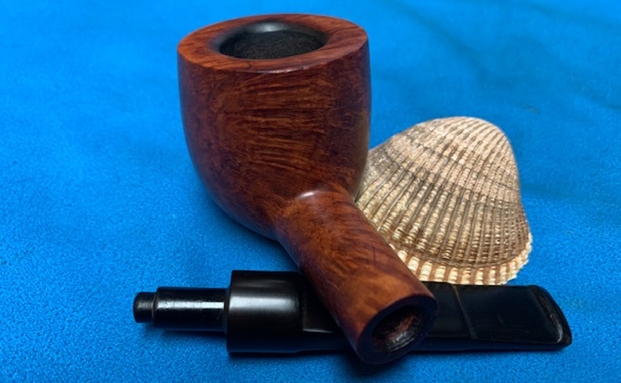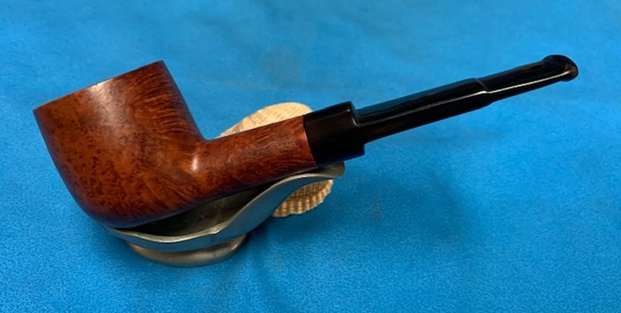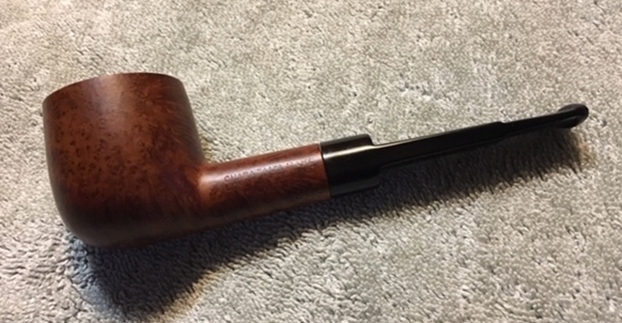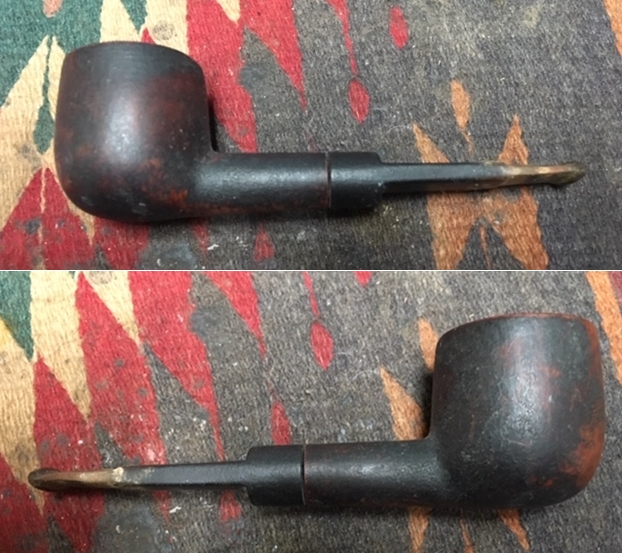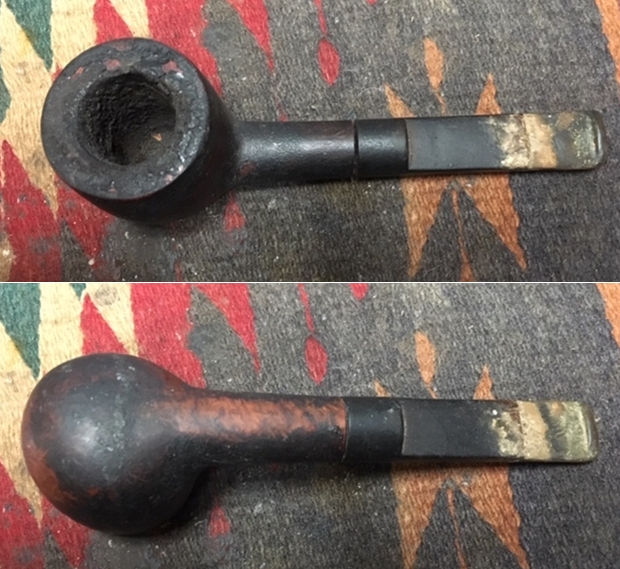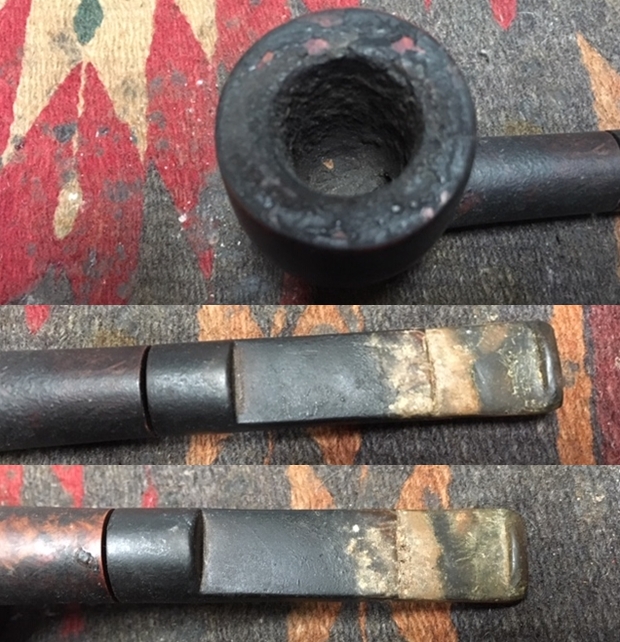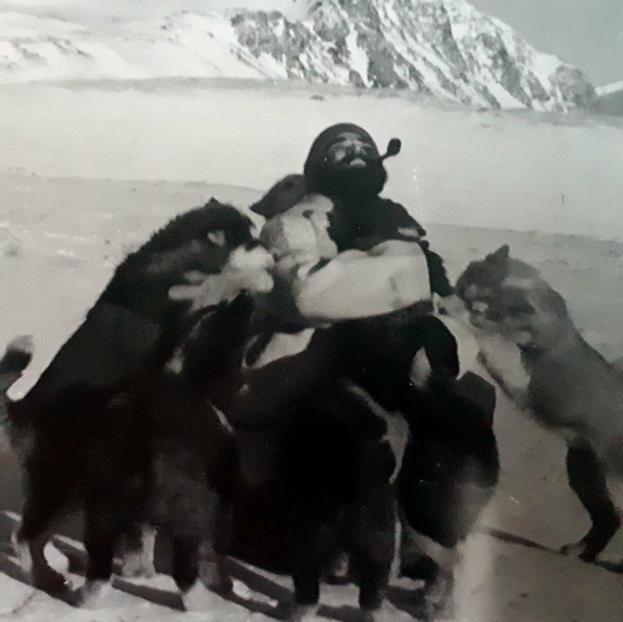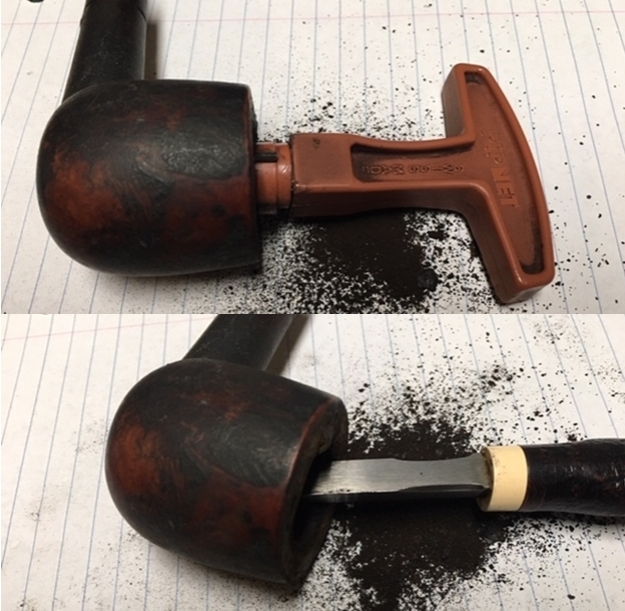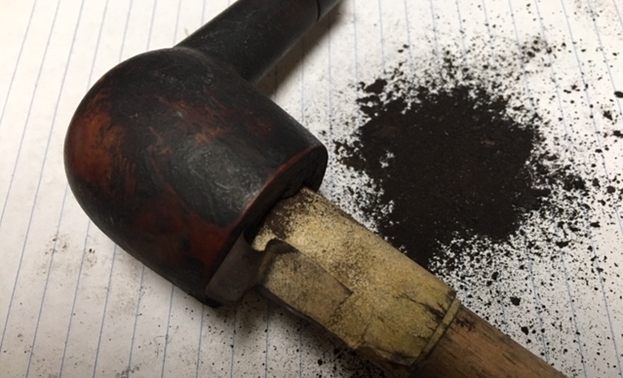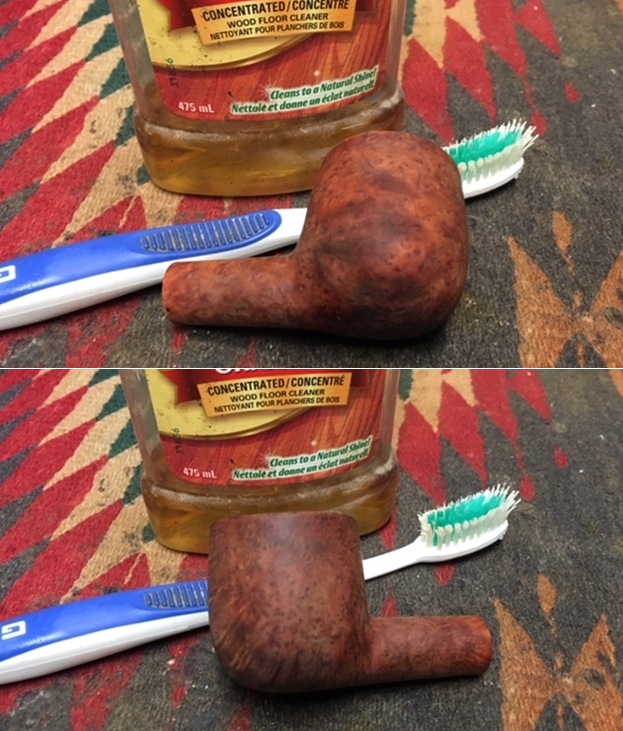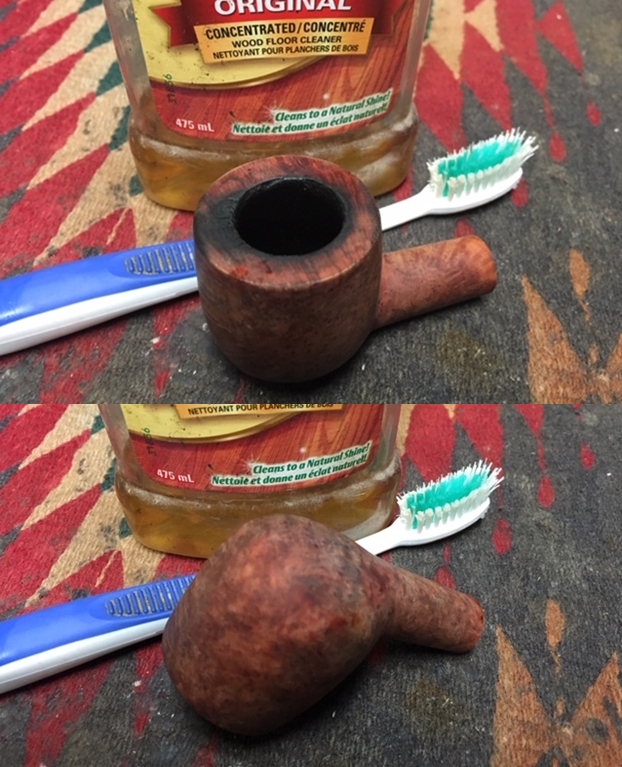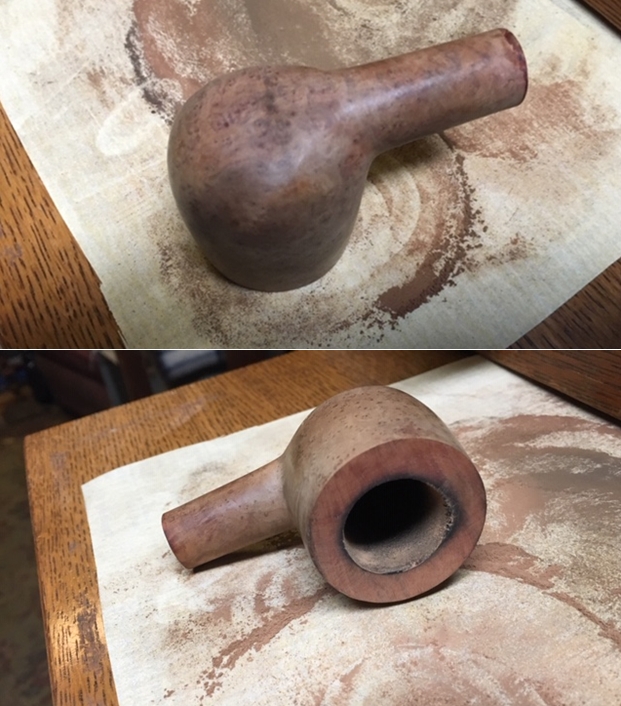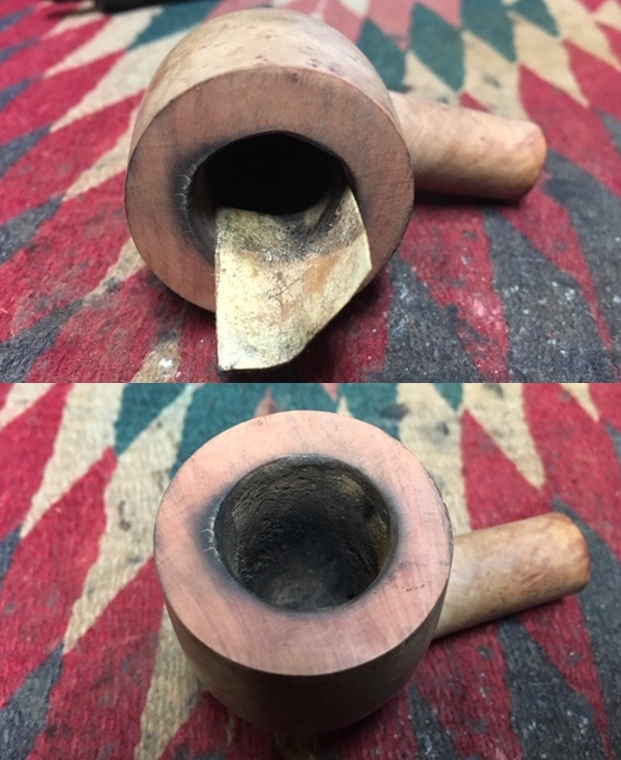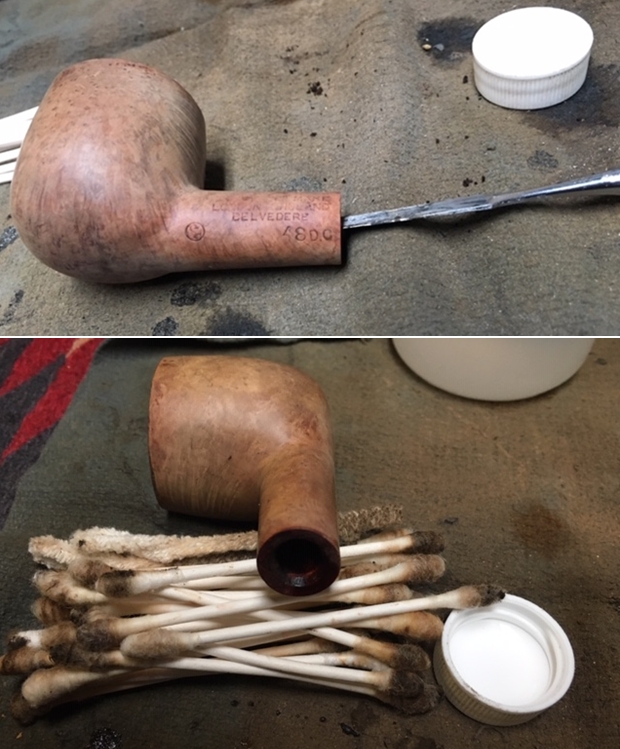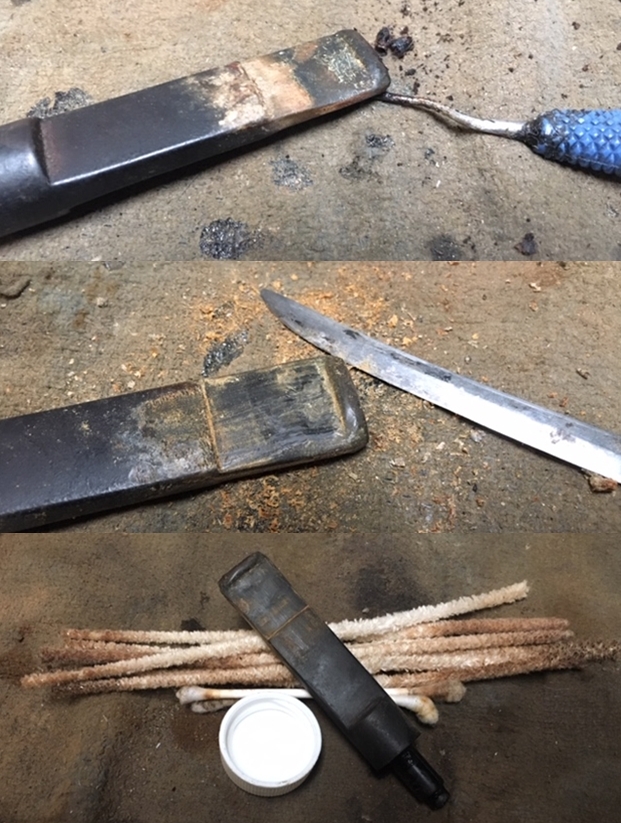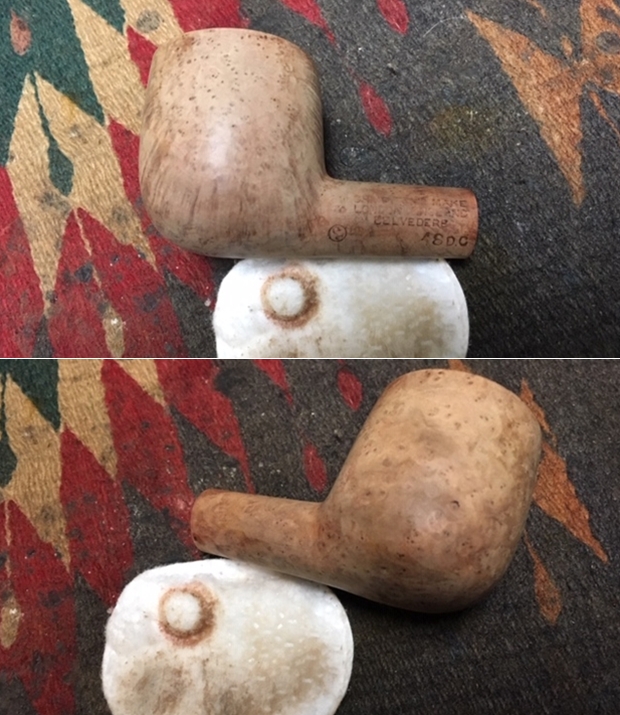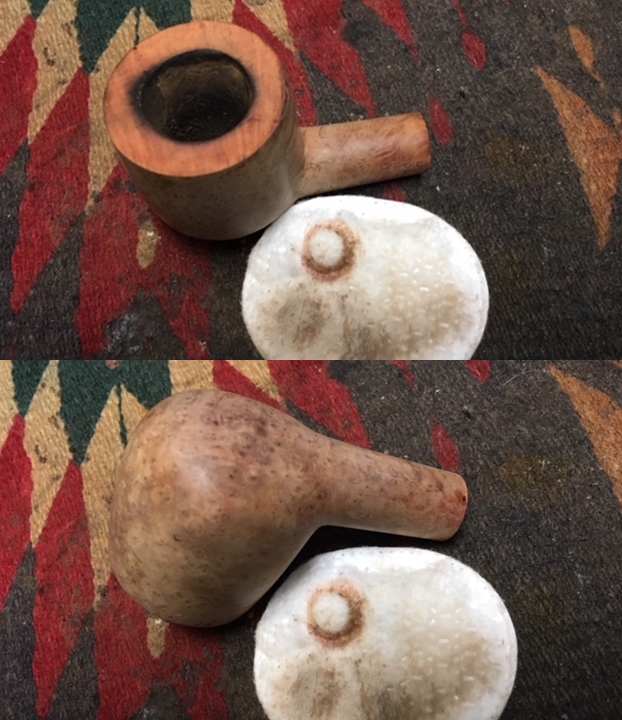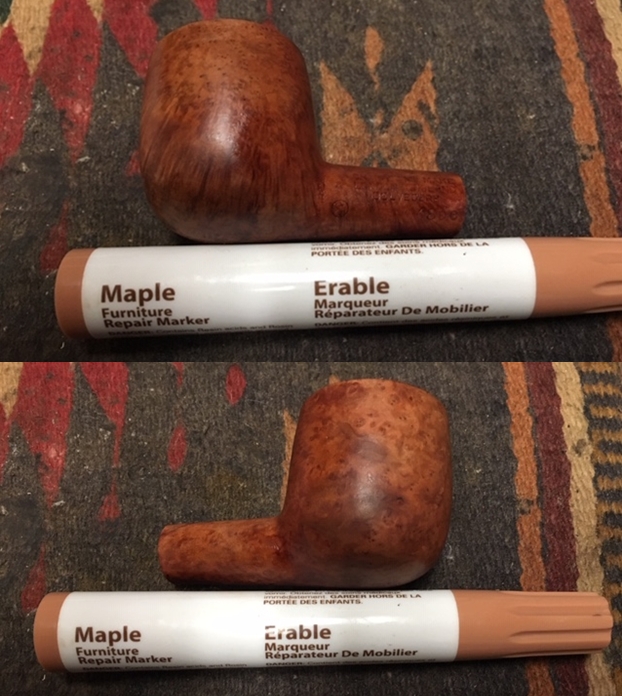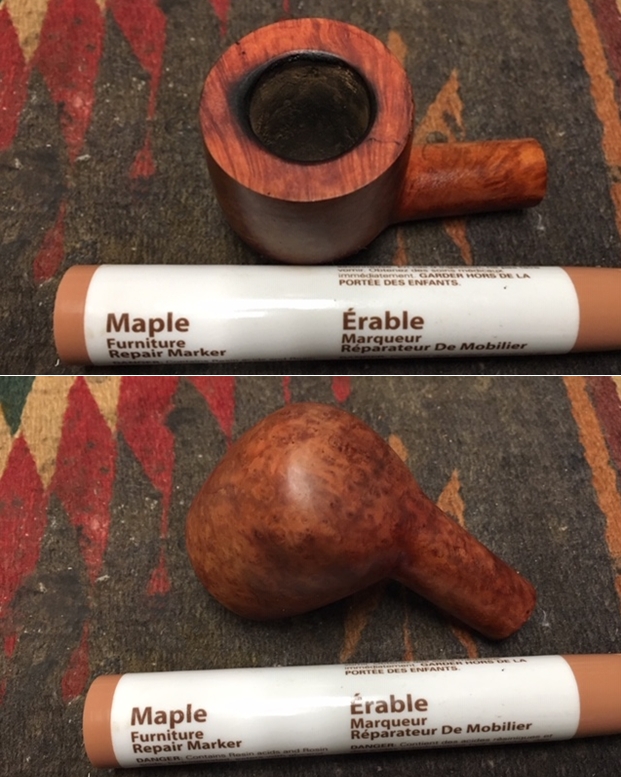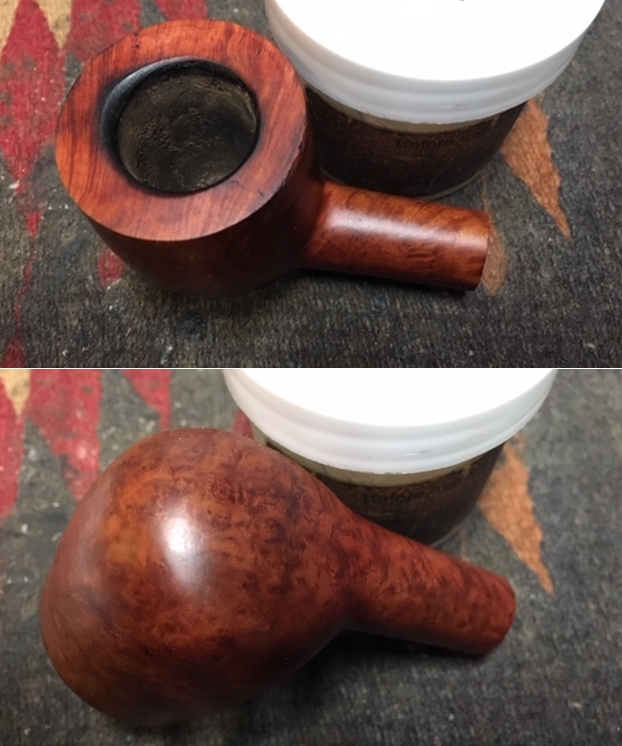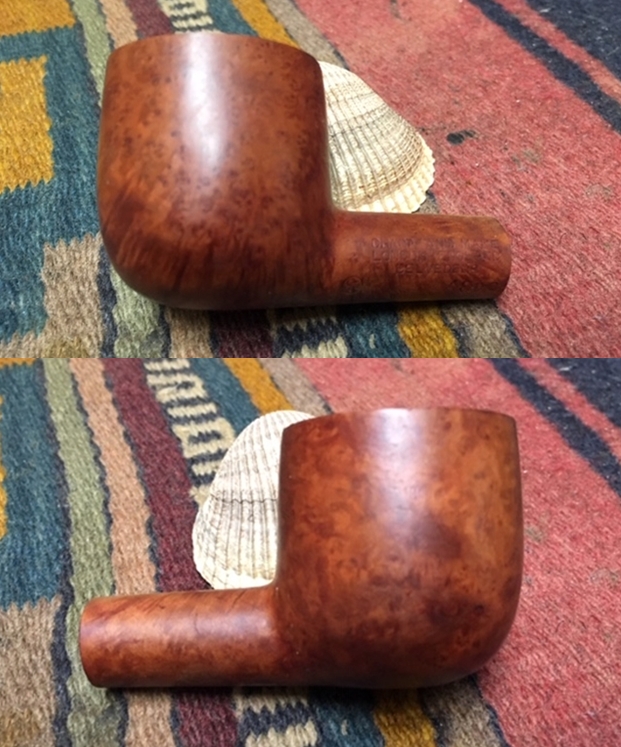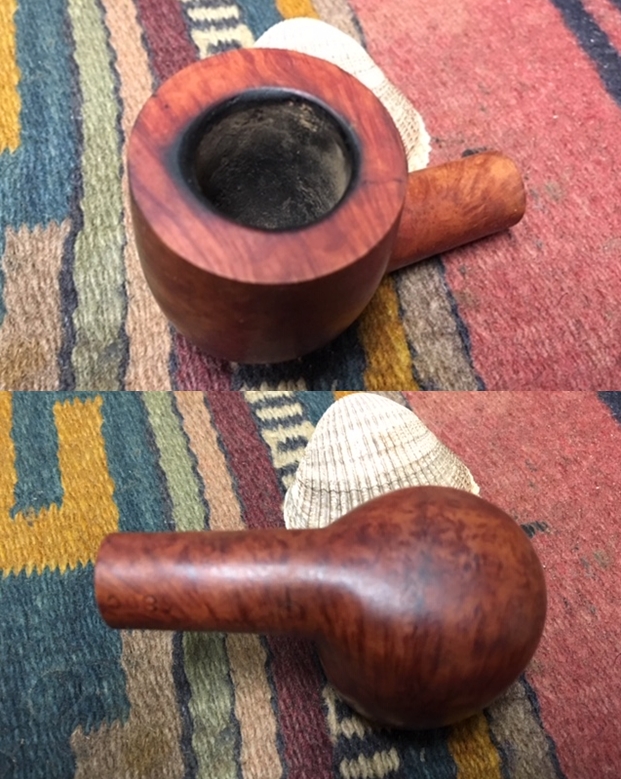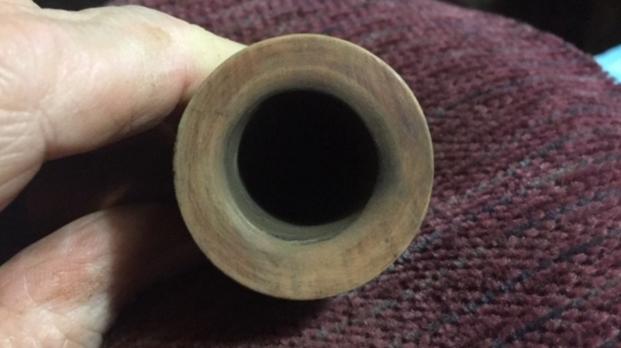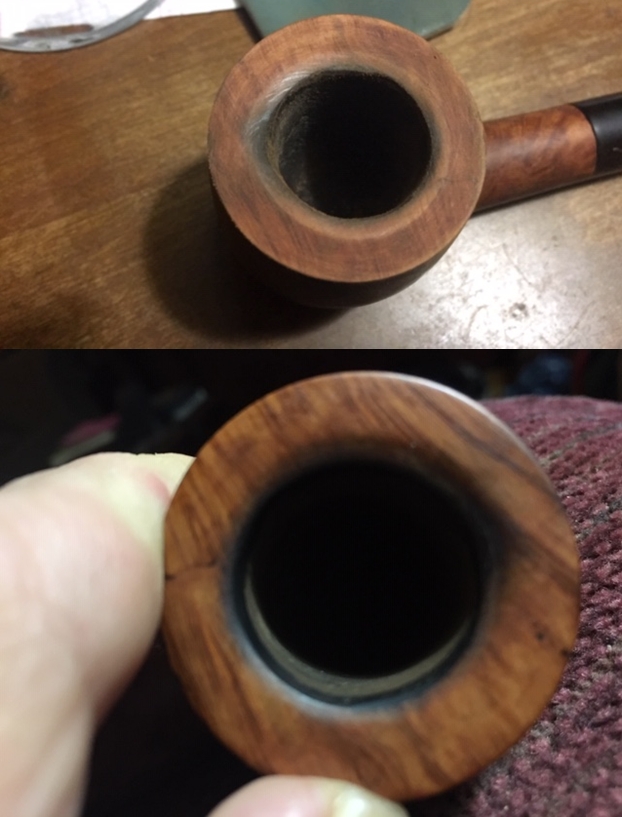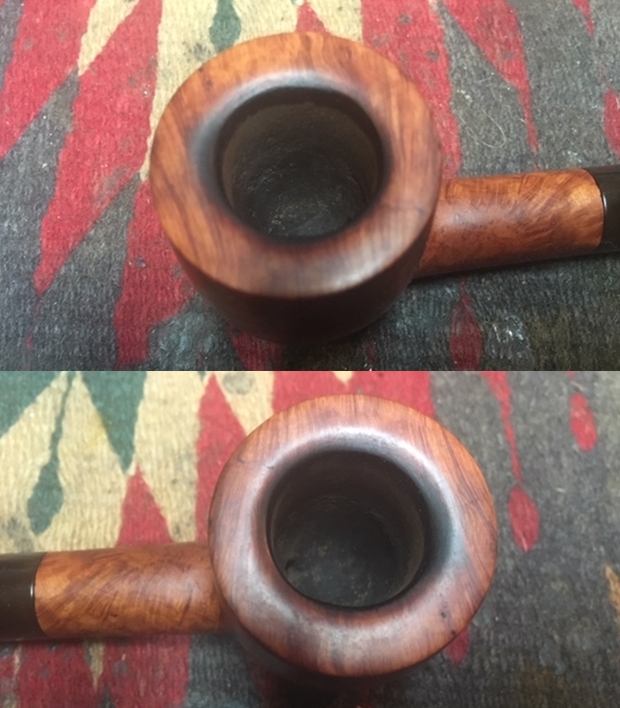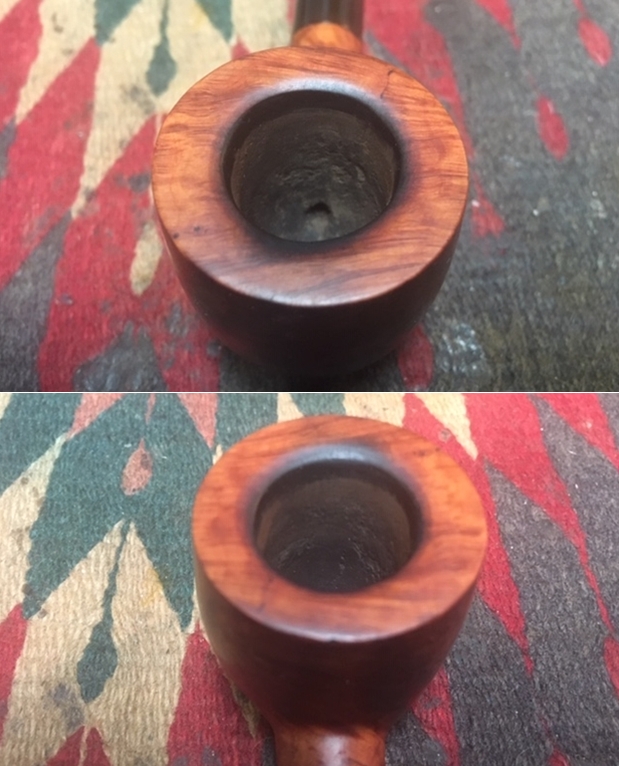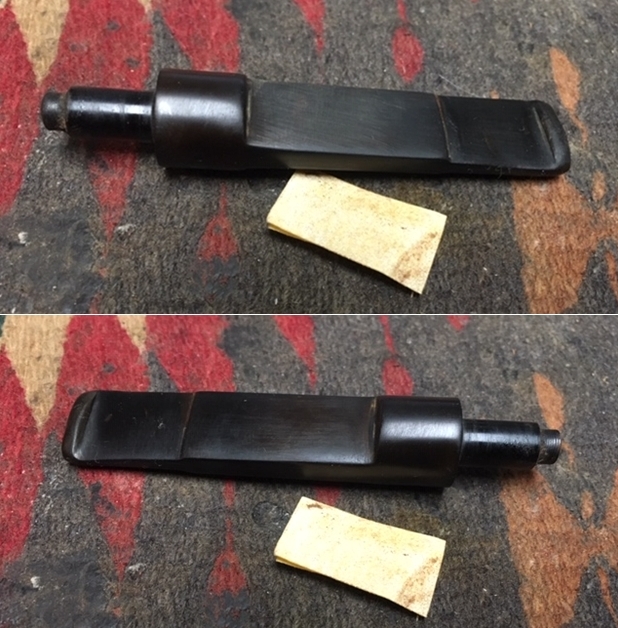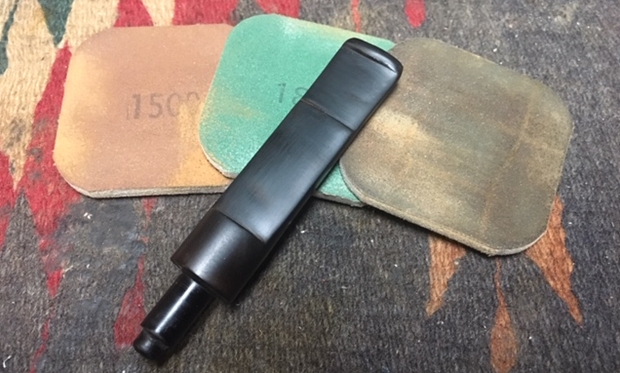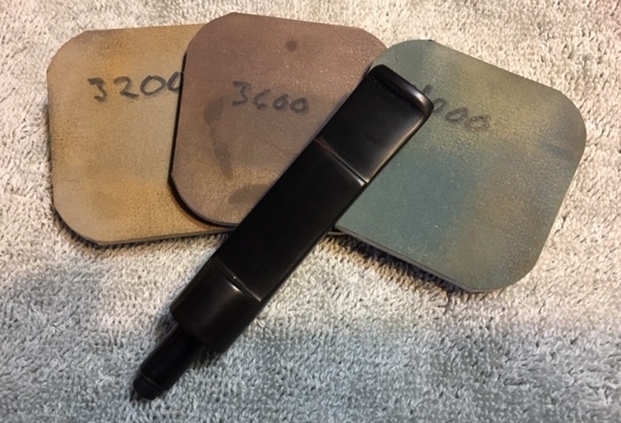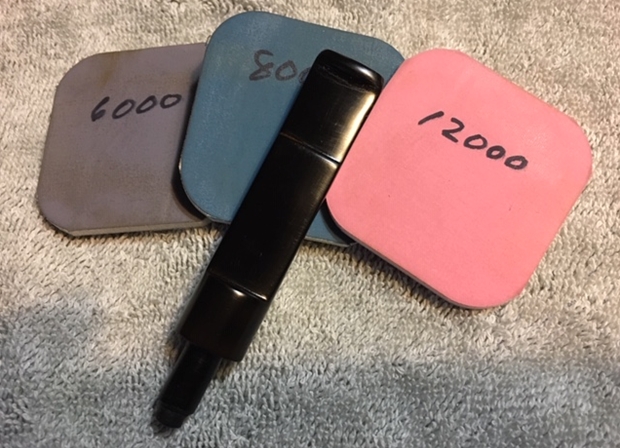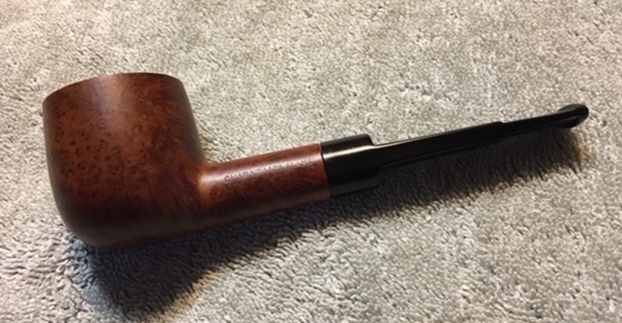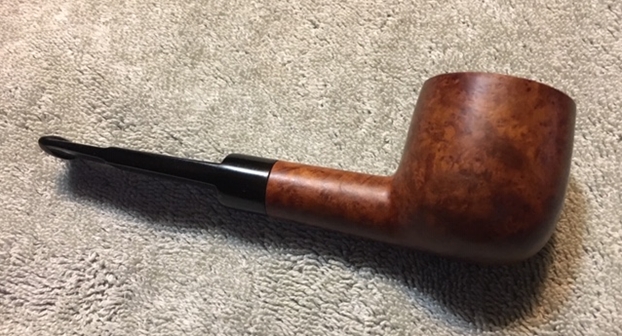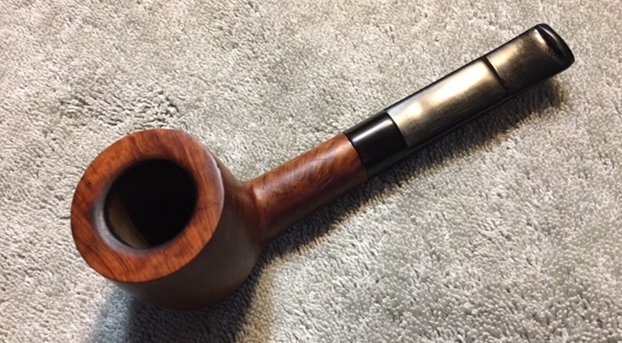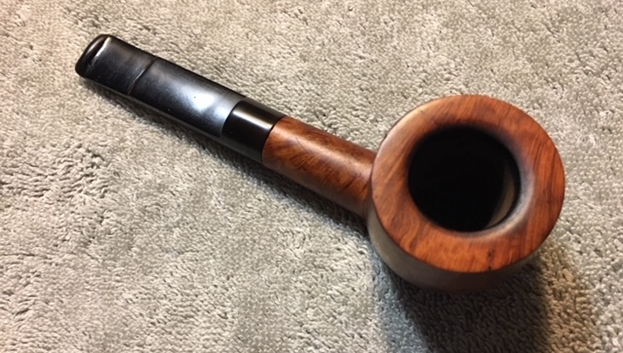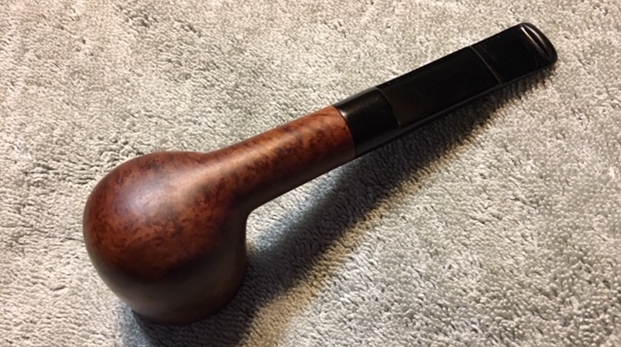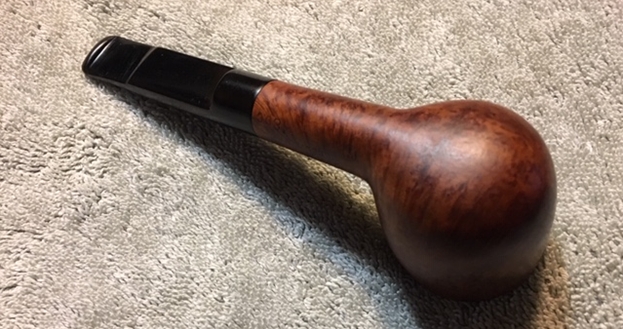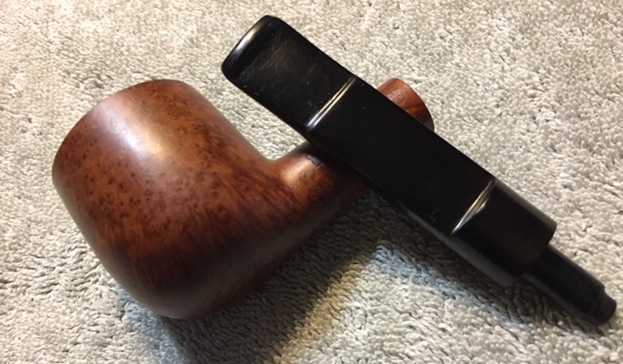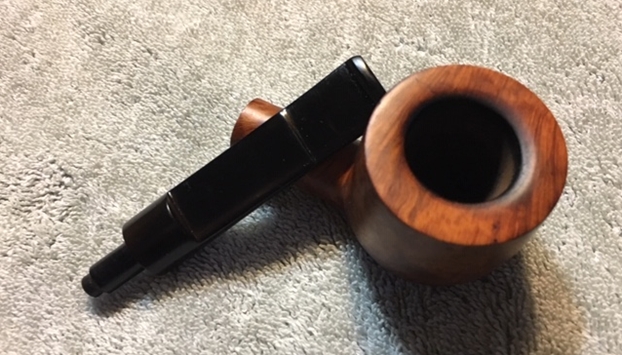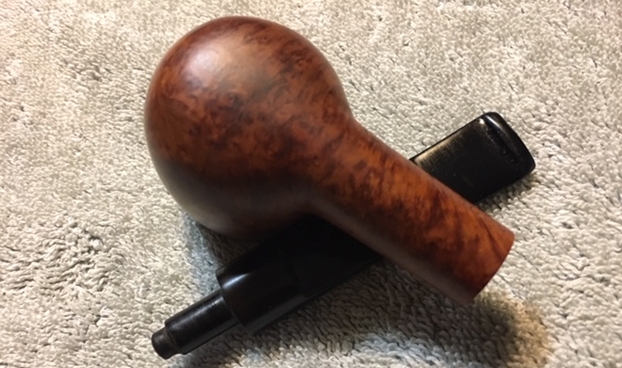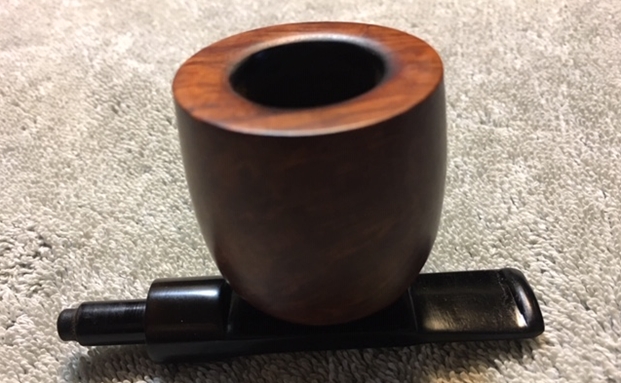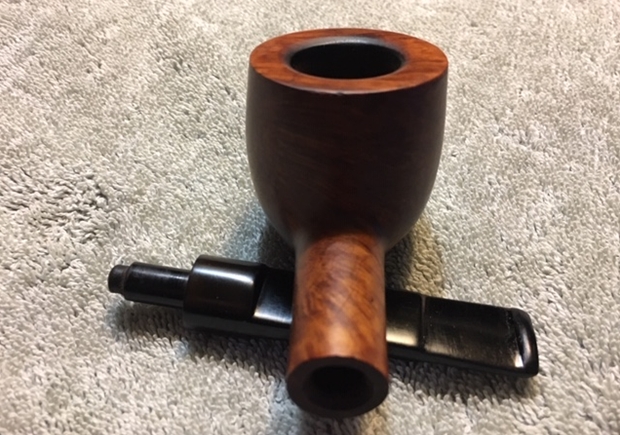Blog by Steve Laug
A fellow Vancouver Pipeman named Alex continues to keep me busy with working on the pipes he is picking up. He has picked up some interesting American and English made pipes. The next of those pipes is an English made Pot. It is quite a stunning pipe with great grain around the bowl. From what I can see it is a flawless piece of briar. The grain is birdseye on the sides of the bowl and cross grain on the front and back. The pipe is stamped on the left side of the shank and it reads Charatan’s Make [over] London England [over] Belvedere. To the left of the stamping is a cursive “L” in a circle and to the right of the stamping is the shape number 48DC. The L stamp and the DC (Double Comfort) stamp both point to the pipe being made during the Lane era of Charatan. The bowl had been reamed before coming to my work table. The rim top was clean other than some darkening on the inner bevel at the front of the bowl. The finish was worn off and very dirty with grime and oils ground into the surface of the bowl and shank. The vulcanite saddle stem is at one time would have had a CP on the left side of the saddle but it had long since been buffed off. The stem was clean but scratched and still having some remnants of oxidation at the sharp edges of the Double Comfort bit. Here are some photos of the pipe when I first received it. 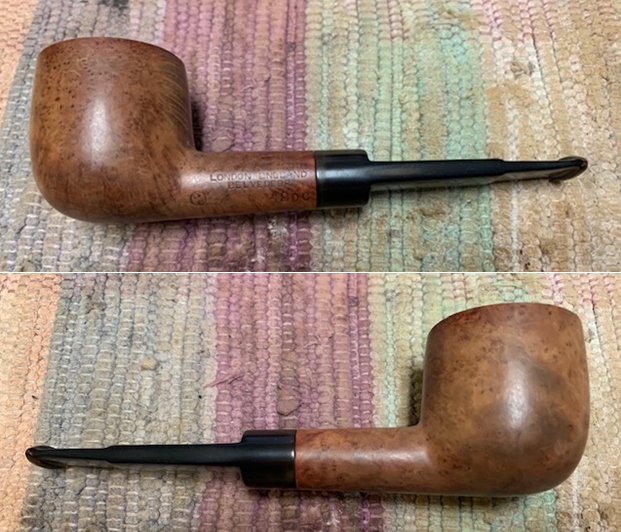
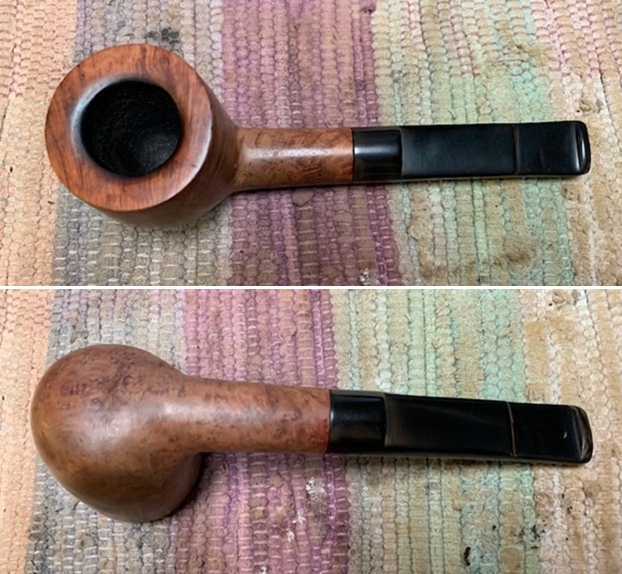 I took a close-up photo of the rim to show the condition of the rim top, bowl and the inner edge of the bowl. You can see the darkening on the front inner bevel of the rim top. The stem was quite clean but someone had sanded and buffed it so it was a bit wavy.
I took a close-up photo of the rim to show the condition of the rim top, bowl and the inner edge of the bowl. You can see the darkening on the front inner bevel of the rim top. The stem was quite clean but someone had sanded and buffed it so it was a bit wavy.  The stamping on the side of the shank is shown in the photo below. It reads as noted above.
The stamping on the side of the shank is shown in the photo below. It reads as noted above. 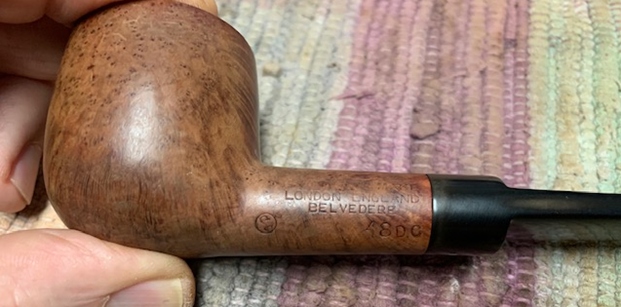 I removed the stem from the shank and took a photo of the flow of the pipe. The pipe was really going to look great once it was cleaned and polished.
I removed the stem from the shank and took a photo of the flow of the pipe. The pipe was really going to look great once it was cleaned and polished.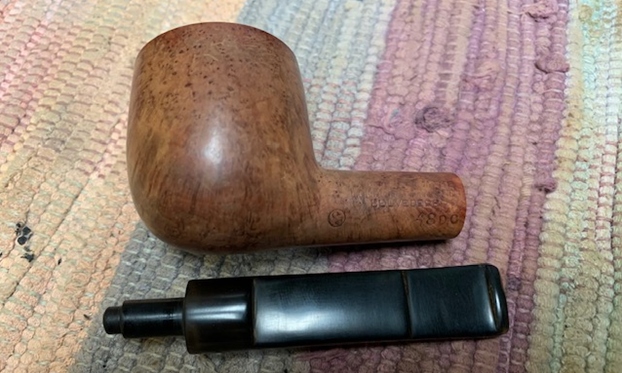 To try to figure out the era of the Charatan’s pipe I was working on I turned to the Pipephil website, Logos and Stampings. There is some really helpful information on each of the lines of Charatan’s Make pipes that entered the market. Here is the link to the section of the site that I turned to (http://www.pipephil.eu/logos/en/logo-charatan.html). There is an alphabetical listing of the lines but the Belvedere they showed had a stem made for a 9mm filter while the one I have is a nonfiltered pipe. The site did give a short history of the brand. I quote the portion that is most pertinent.
To try to figure out the era of the Charatan’s pipe I was working on I turned to the Pipephil website, Logos and Stampings. There is some really helpful information on each of the lines of Charatan’s Make pipes that entered the market. Here is the link to the section of the site that I turned to (http://www.pipephil.eu/logos/en/logo-charatan.html). There is an alphabetical listing of the lines but the Belvedere they showed had a stem made for a 9mm filter while the one I have is a nonfiltered pipe. The site did give a short history of the brand. I quote the portion that is most pertinent.
The brand was founded in 1863 by Frederik Charatan. When his father retired in 1910, Reuben Charatan took over the family business. All the pipes were handmade until 1973. The brand name has been overtaken by Dunhill in 1978 and sold in 1988 to James B. Russell Inc.(NJ, USA). During the period 1988-2002 Charatans were crafted by Butz Choquin in St Claude (France). Dunhill re-purchased Charatan brand name in 2002 and Colin Fromm (Invicta Briars, Castleford) followed up on freehand production.
I turned to Pipedia to see if I could find more information on the brand and possibly a link to the Belvedere line (https://pipedia.org/wiki/Charatan) but once again in the general article it was not listed. It did give a little more historical information. I quote the pertinent parts and have highlighted in red the sections that give information on this particular pipe.
In 1863 Frederick Charatan, a Russian/Jewish immigrant, opened a shop in Mansell Street, located in the borough of Tower Hamlets, London E1, where he began to carve Meerschaum pipes. These pipes got very popular soon, and thus Charatan moved to a bigger workshop in Prescot Street, just around the corner. Here he began to make briar pipes which should make the name famous the world over. Charatan was the first brand to make entirely hand-made briars from the rough block to the finished pipe including the stems. The nomenclature “Charatan’s Make” refers to this method of production and was meant to differ Charatan from other brands who “assembled” pipes from pre-drilled bowls and delivered mouthpieces.
Being the undisputed No. 1 in English pipemaking, Charatan was approached by Alfred Dunhill who was unsatisfied with the quality of the pipes he imported from France. During 1908 – 1910 Dunhill bought pipes from Charatan paying exorbitant prices to ensure he had some of the very best pipes for sale in England. In 1910 he lured away Joel Sasieni, one of Charatan’s best carvers, and opened his own small pipe workshop on 28 Duke Street. On the retirement of his father in 1910 Reuben Charatan took over the family business…
…The pre-Lane period (prior to 1955) and the Lane era pipes (1955 to until sometime between 1979 – 1984) are of primary interest the collector. The Lane era is often quoted as beginning about 1950… Charatan records are almost non-existent before Lane due to a factory fire, making it difficult to date pre-Lane pipes. Charatan used 4 basic grades prior to 1950: Supreme, Selected, Executive, and Belvedere. After 1950 Herman Lane’s influence began, and the grades started to expand. In 1955 Lane took over sole distributorship of Charatan in the US. In 1957 he introduced the Supreme S. Most of his other introductions were from the 60’s and early 70’s…
I continue digging further into the dating of the pipe, but what I had found was a good start for me. If some of you would like to try your hand at dating it more accurately as to the time period it came out you might want to check out the article on Pipedia on Dating Charatans (https://pipedia.org/wiki/Dating_of_Charatans).
I also reread the article on Pipedia by the Italian fellow who contributed some really helpful information on the brand (https://pipedia.org/wiki/Charatan_-_Milan_2014). I quote the section on the Second period: Reuben Charatan 1910 – c. 1962
– In 1962 Herman Lane took over the business from the Charatan family, although he had already influenced production from the 1950s.
– The pipes were mostly larger than the previous ones and corresponded in size to Dunhill group 5. These are slightly less rare, but still difficult to find.
– Stem: Usually in ebonite, saddle shaped or tapered, bearing a fine “CP” stamp, underbore system (see below) used when necessary.
– Shank: The shape code is stamped on it together with the nomenclature “CHARATAN’S MAKE LONDON ENGLAND” arranged in two lines. From 1955 onwards on the models marketed for the USA there is also a serif and circled capital “L” (but not all models bear this) which resembles the pound sterling symbol. The “L” is for Lane, the importer.
From 1958, Lane changed the nomenclature for models marketed for the US to clarify the message: “MADE BY HAND”. In this period the underbore was introduced. Its manufacturing period ranged between 1920 and c.1930. This model was equipped with a duralumin plunger trap fitted in the stem, which served to clean the residue more easily. This particular model bore a special stamp on the stem, and also had its own catalogue…
QUALITY GRADES…The stem did not only display the stamps mentioned above. Another stamp that can help dating is the one referring to the quality of the pipe. Until Herman Lane arrived on the scene there were four quality grades. Starting with the lowest: Belvedere, Executive, Selected, and Supreme. Lane went on to add higher grades from time to time: Supreme S, Supreme S100, S150, S200, S250, S300, Coronation, Royal Achievement, Crown Achievement, and Summa Cum Laude; these last three are extremely rare and almost impossible to find. He also invented other, different grades, even changing the previous pipe classification standards. We will not go into detail here, but it means that if we find an S100 or Coronation the pipe was manufactured following Herman Lane’s acquisition. In particular, the FH mark, or Freehand pipe was commissioned to the famous Danish craftsman, Preben Holm
Now it was time to work on the pipe itself. I scrubbed the exterior of the bowl with a tooth brush and undiluted Murphy’s Oil Soap to get the grime and debris out of the briar. I rinsed it with running water and dried it off with a towel. With that the outside was clean… progress! 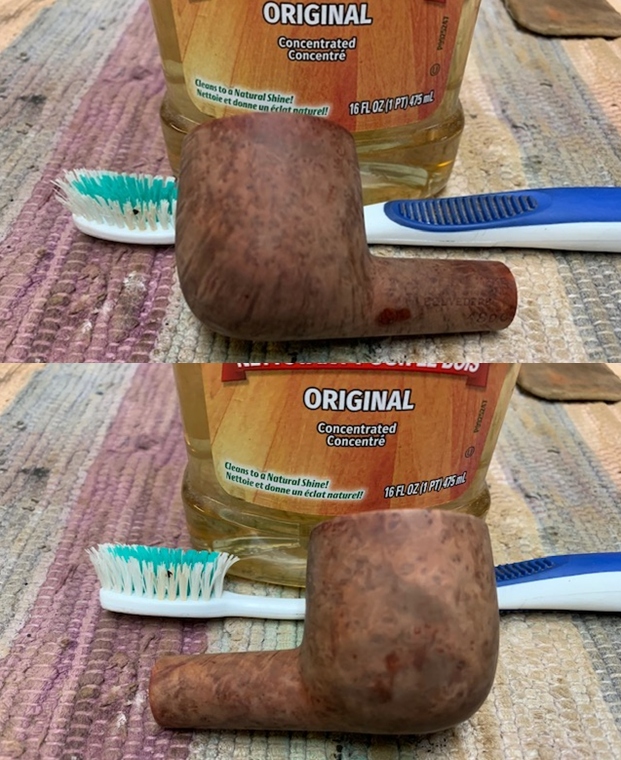
 I cleaned out the mortise, shank in the briar and airway in the stem with pipe cleaners, cotton swabs and 99% isopropyl alcohol. The pipe was dirty with lots of tars and oils.
I cleaned out the mortise, shank in the briar and airway in the stem with pipe cleaners, cotton swabs and 99% isopropyl alcohol. The pipe was dirty with lots of tars and oils.  I worked on the damage to the inner edge of the bowl with 220 grit sandpaper to remove as much of the damage as possible and bring the bowl back to round. I took a photo of the rim top after the cleanup to show the progress in cleaning up the edges.
I worked on the damage to the inner edge of the bowl with 220 grit sandpaper to remove as much of the damage as possible and bring the bowl back to round. I took a photo of the rim top after the cleanup to show the progress in cleaning up the edges. 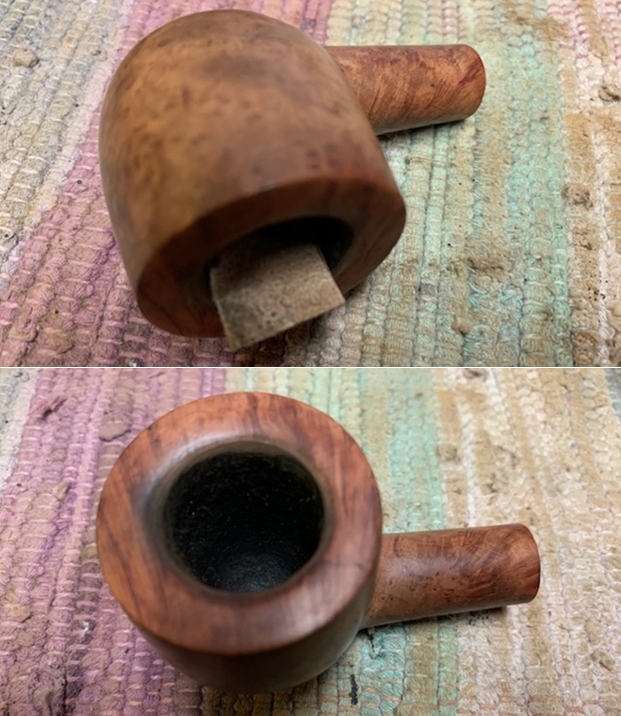 I polished the briar with micromesh sanding pads – wet sanding with 1500-12000 grit pads and wiping the bowl down with a damp cloth after each pad. The grain is really beginning to stand out and the rim top is blending in quite well.
I polished the briar with micromesh sanding pads – wet sanding with 1500-12000 grit pads and wiping the bowl down with a damp cloth after each pad. The grain is really beginning to stand out and the rim top is blending in quite well. 
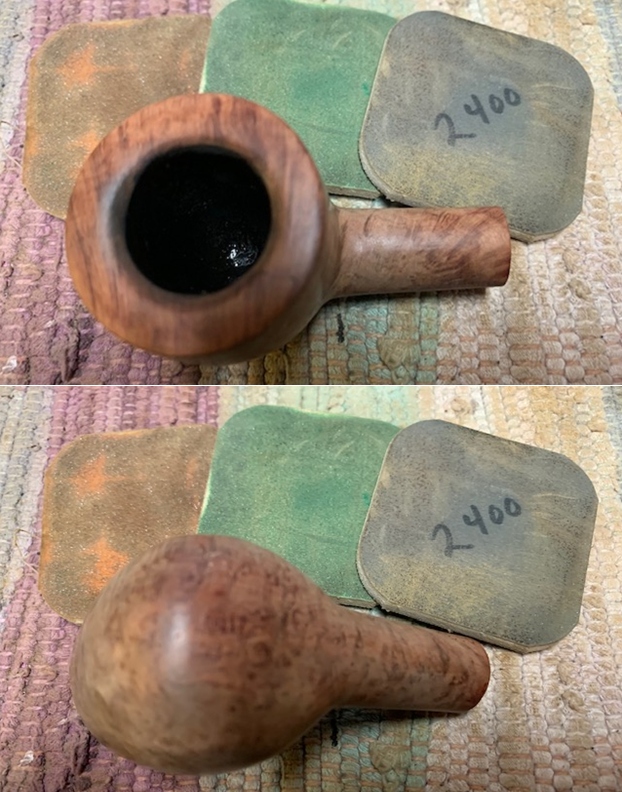


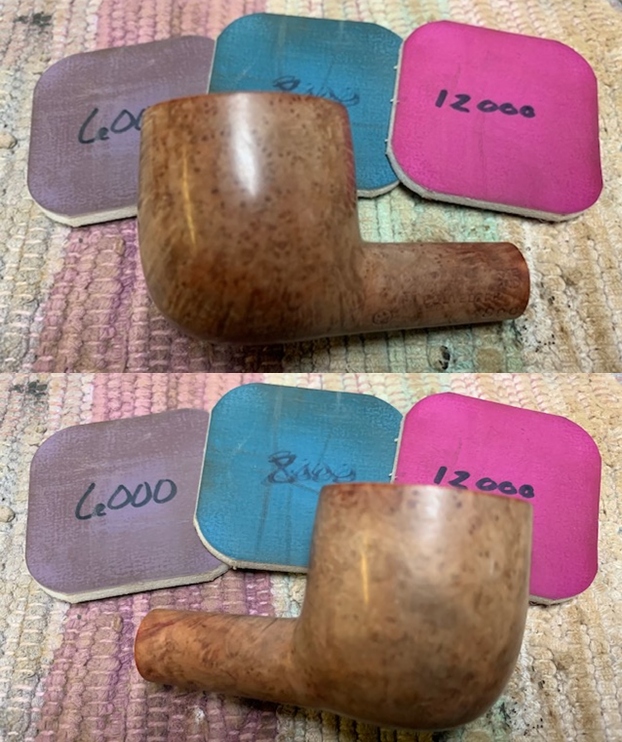
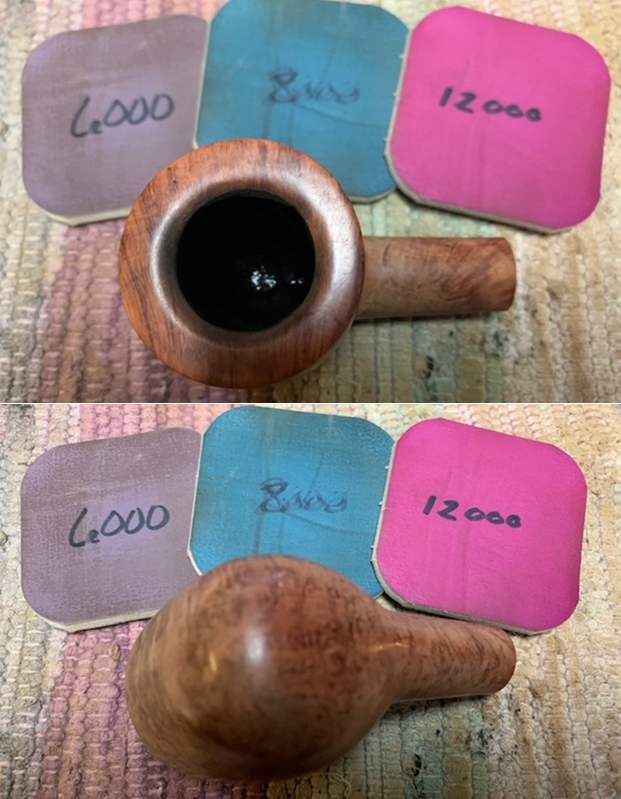 I worked some Before & After Restoration Balm into the surface of the briar with my fingertips to clean, enliven and protect it. I let the balm sit for a little while and then buffed with a cotton cloth to raise the shine. The following photos show the bowl at this point in the restoration process. I am very happy with the results.
I worked some Before & After Restoration Balm into the surface of the briar with my fingertips to clean, enliven and protect it. I let the balm sit for a little while and then buffed with a cotton cloth to raise the shine. The following photos show the bowl at this point in the restoration process. I am very happy with the results. 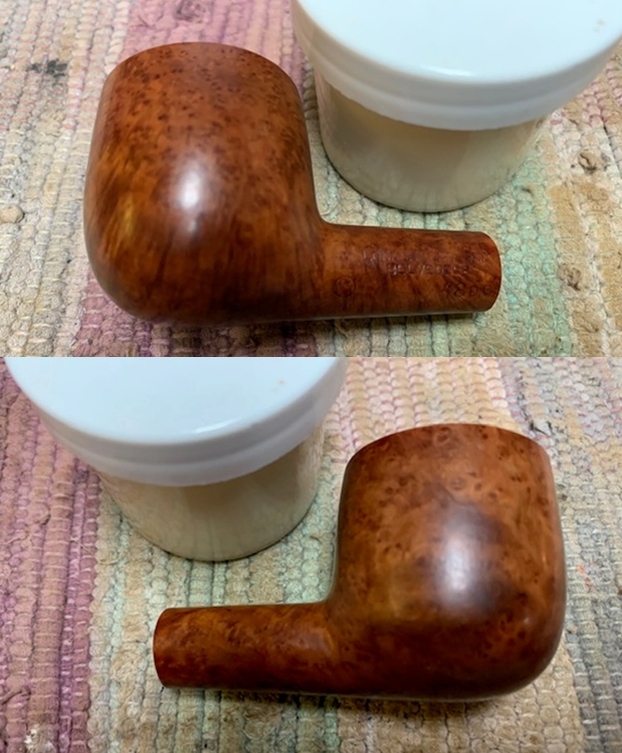

 I set the bowl aside and turned my attention to the stem. I scrubbed the stubborn areas of the creases on the stem with Soft Scrub until they were clean. It too a bit of work but I was able to remove much of the oxidation.
I set the bowl aside and turned my attention to the stem. I scrubbed the stubborn areas of the creases on the stem with Soft Scrub until they were clean. It too a bit of work but I was able to remove much of the oxidation. 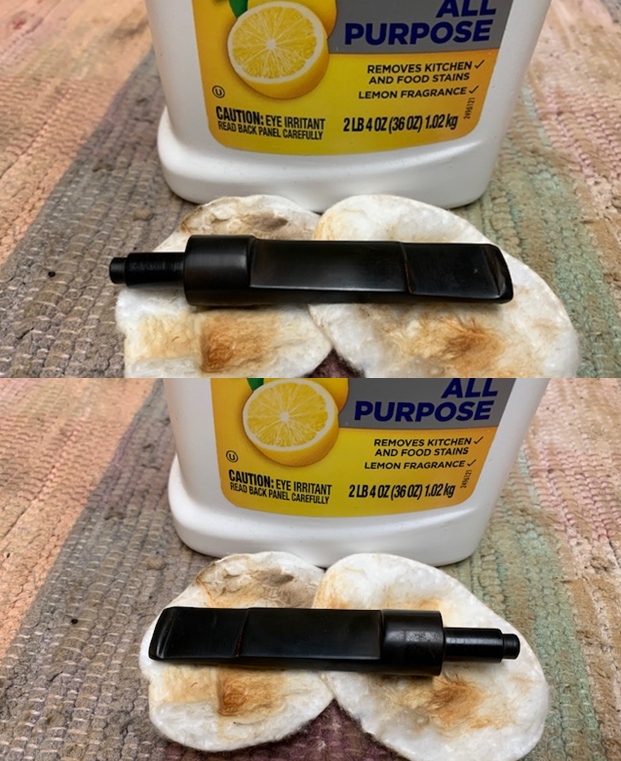 There were several small tooth marks on the surface of the stem on each side. I filled them in with Loctite 380 Black CA glue and set the stem aside to let the repairs cure.
There were several small tooth marks on the surface of the stem on each side. I filled them in with Loctite 380 Black CA glue and set the stem aside to let the repairs cure. 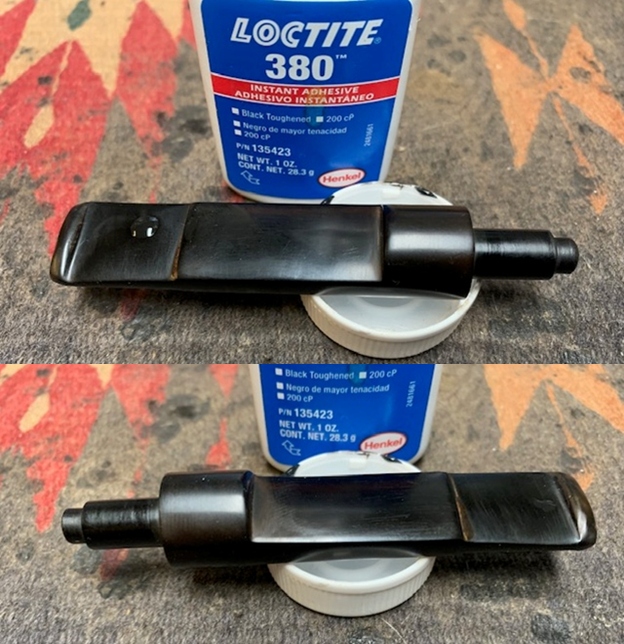 I smoothed out the repairs to blend them into the surface of the stem with 220 grit sandpaper. I also worked on the creases to remove oxidation as well as flattening some of the waviness of the stem surface. I started the polishing of the stem with 400 grit wet dry sandpaper.
I smoothed out the repairs to blend them into the surface of the stem with 220 grit sandpaper. I also worked on the creases to remove oxidation as well as flattening some of the waviness of the stem surface. I started the polishing of the stem with 400 grit wet dry sandpaper. 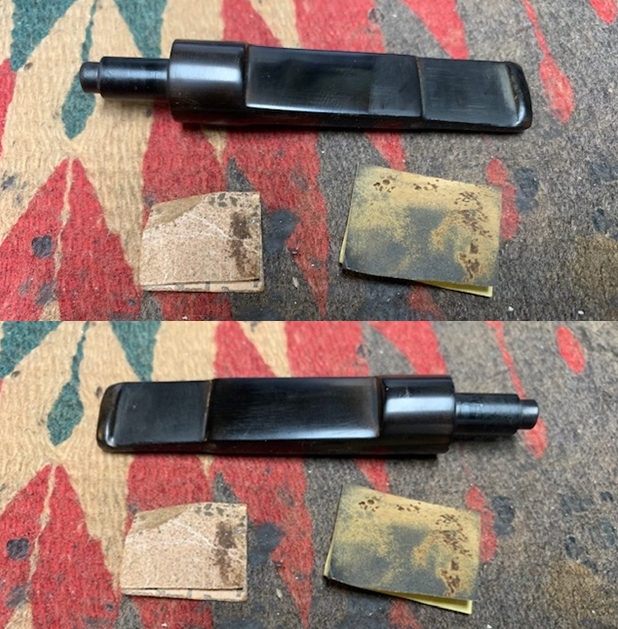 I polished the stem with micromesh sanding pads – wet sanding with 1500-12000 grit sanding pads and wiping it down after each pad with Obsidian Oil. I polished the stem with Before & After Stem Polish – both Fine and Extra Fine. I wiped it down a final time with Obsidian Oil when I finished.
I polished the stem with micromesh sanding pads – wet sanding with 1500-12000 grit sanding pads and wiping it down after each pad with Obsidian Oil. I polished the stem with Before & After Stem Polish – both Fine and Extra Fine. I wiped it down a final time with Obsidian Oil when I finished. 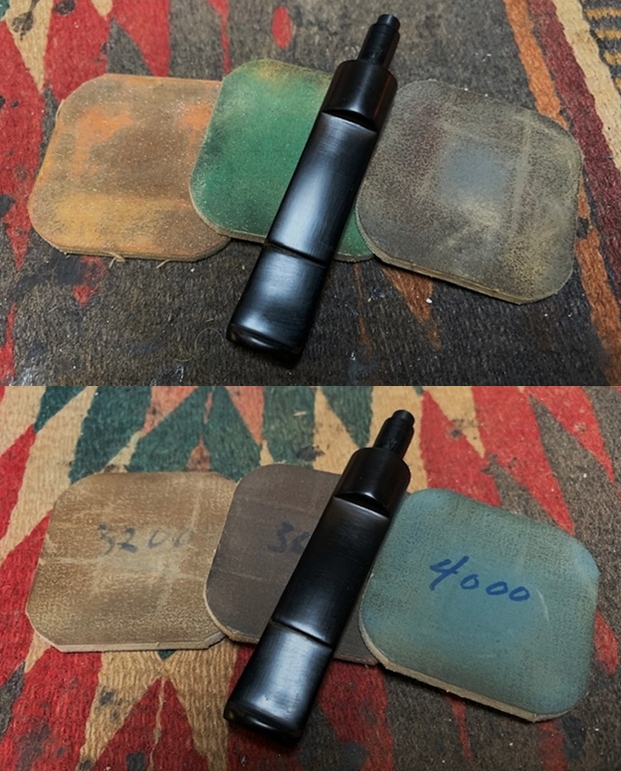
 This Charatan’s Make Belvedere 48DC Pot with a vulcanite saddle stem turned out to be a real beauty. The carver really maximized the grain with the shape of the pipe. Everything about the pipe – the finish, the rim top and the cut of the briar work well to highlight the grain around the bowl. I polished stem and the bowl with Blue Diamond polish on the buffing wheel and the finish just popped and came alive. I gave the bowl and the stem multiple coats of carnauba wax. I buffed the pipe with a clean buffing pad to raise the shine. I hand buffed it with a microfiber cloth to deepen the shine. The pipe polished up pretty nicely. The pipe took on life with the buffing. The rich brown finish works well with the polished vulcanite stem. The finished pipe has a rich look that is quite catching. Have a look at it with the photos below. The shape, finish and flow of the pipe and stem are very well done. The dimensions are Length: 5 ½ inches, Height: 1 ½ inches, Outside diameter of the bowl: 1 ½ inches, Chamber diameter: ¾ of an inch. The Charatan’s Make Belvedere will back in the box of pipes that I am working on for Alex. I am looking forward to what he will think of this one. Thanks for walking through the restoration with me as I worked over another estate pipe.
This Charatan’s Make Belvedere 48DC Pot with a vulcanite saddle stem turned out to be a real beauty. The carver really maximized the grain with the shape of the pipe. Everything about the pipe – the finish, the rim top and the cut of the briar work well to highlight the grain around the bowl. I polished stem and the bowl with Blue Diamond polish on the buffing wheel and the finish just popped and came alive. I gave the bowl and the stem multiple coats of carnauba wax. I buffed the pipe with a clean buffing pad to raise the shine. I hand buffed it with a microfiber cloth to deepen the shine. The pipe polished up pretty nicely. The pipe took on life with the buffing. The rich brown finish works well with the polished vulcanite stem. The finished pipe has a rich look that is quite catching. Have a look at it with the photos below. The shape, finish and flow of the pipe and stem are very well done. The dimensions are Length: 5 ½ inches, Height: 1 ½ inches, Outside diameter of the bowl: 1 ½ inches, Chamber diameter: ¾ of an inch. The Charatan’s Make Belvedere will back in the box of pipes that I am working on for Alex. I am looking forward to what he will think of this one. Thanks for walking through the restoration with me as I worked over another estate pipe.